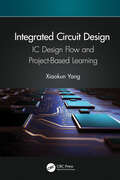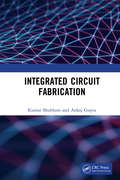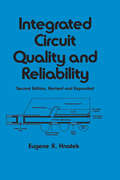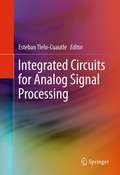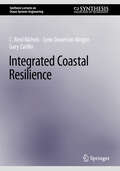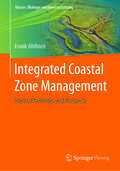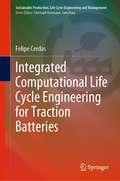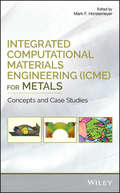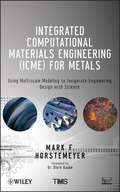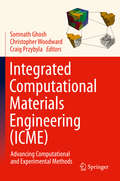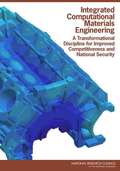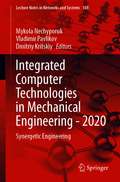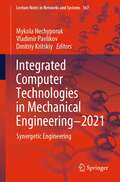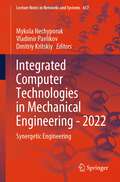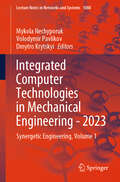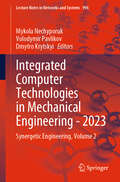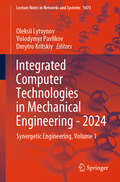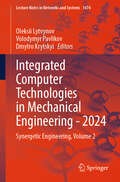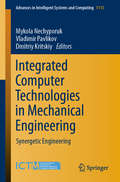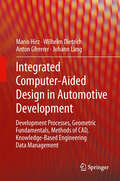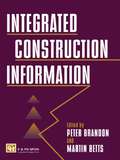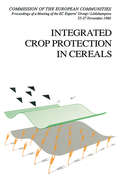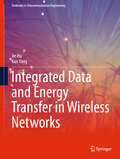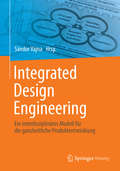- Table View
- List View
Integrated Circuit Design: IC Design Flow and Project-Based Learning
by Xiaokun YangThis textbook seeks to foster a deep understanding of the field by introducing the industry integrated circuit (IC) design flow and offering tape-out or pseudo tape-out projects for hands-on practice, facilitating project-based learning (PBL) experiences.Integrated Circuit Design: IC Design Flow and Project-Based Learning aims to equip readers for entry-level roles as IC designers in the industry and as hardware design researchers in academia. The book commences with an overview of the industry IC design flow, with a primary focus on register-transfer level (RTL) design, the automation of simulation and verification, and system-on-chip (SoC) integration. To build connections between RTL design and physical hardware, FPGA (field-programmable gate array) synthesis and implementation is utilized to illustrate the hardware description and performance evaluation. The second objective of this book is to provide readers with practical, hands-on experience through tape-out or pseudo tape-out experiments, labs, and projects. These activities are centered on coding format, industry design rules (synthesizable Verilog designs, clock domain crossing, etc.), and commonly-used bus protocols (arbitration, handshaking, etc.), as well as established design methodologies for widely-adopted hardware components, including counters, timers, finite state machines (FSMs), I2C, single/dual-port and ping-pong buffers/register files, FIFOs, floating-point units (FPUs), numerical hardware (Fourier transform, matrix-matrix multiplication, etc.), direct memory access (DMA), image processing designs, neural networks, and more.The textbook caters to a diverse readership, including junior and senior undergraduate students, as well as graduate students pursuing degrees in electrical engineering, computer engineering, computer science, and related fields. The target audience is expected to have a basic understanding of Boolean Algebra and Karnaugh Maps, as well as prior familiarity with digital logic components such as AND/OR gates, latches, and flip-flops. The book will also be useful for entry-level RTL designers and verification engineers who are embarking on their journey in application-specific IC (ASIC) and FPGA design industry.
Integrated Circuit Fabrication
by Kumar Shubham Ankaj GuptaThis book covers theoretical and practical aspects of all major steps in the fabrication sequence. This book can be used conveniently in a semester length course on integrated circuit fabrication. This text can also serve as a reference for practicing engineer and scientist in the semiconductor industry. IC Fabrication are ever demanding of technology in rapidly growing industry growth opportunities are numerous. A recent survey shows that integrated circuit currently outnumber humans in UK, USA, India and China. The spectacular advances in the development and application of integrated circuit technology have led to the emergence of microelectronic process engineering as an independent discipline. Integrated circuit fabrication text books typically divide the fabrication sequence into a number of unit processes that are repeated to form the integrated circuit. The effect is to give the book an analysis flavor: a number of loosely related topics each with its own background material.Note: T& F does not sell or distribute the Hardback in India, Pakistan, Nepal, Bhutan, Bangladesh and Sri Lanka.
Integrated Circuit Quality and Reliability (Electrical and Computer Engineering)
by Eugene R. HnatekExamines all important aspects of integrated circuit design, fabrication, assembly and test processes as they relate to quality and reliability. This second edition discusses in detail: the latest circuit design technology trends; the sources of error in wafer fabrication and assembly; avenues of contamination; new IC packaging methods; new in-line process monitors and test structures; and more.;This work should be useful to electrical and electronics, quality and reliability, and industrial engineers; computer scientists; integrated circuit manufacturers; and upper-level undergraduate, graduate and continuing-education students in these disciplines.
Integrated Circuits for Analog Signal Processing
by Esteban Tlelo-CuautleThis book presents theory, design methods and novel applications for integrated circuits for analog signal processing. The discussion covers a wide variety of active devices, active elements and amplifiers, working in voltage mode, current mode and mixed mode. This includes voltage operational amplifiers, current operational amplifiers, operational transconductance amplifiers, operational transresistance amplifiers, current conveyors, current differencing transconductance amplifiers, etc. Design methods and challenges posed by nanometer technology are discussed and applications described, including signal amplification, filtering, data acquisition systems such as neural recording, sensor conditioning such as biomedical implants, actuator conditioning, noise generators, oscillators, mixers, etc. Presents analysis and synthesis methods to generate all circuit topologies from which the designer can select the best one for the desired application; Includes design guidelines for active devices/elements with low voltage and low power constraints;Offers guidelines for selecting the right active devices/elements in the design of linear and nonlinear circuits;Discusses optimization of the active devices/elements for process and manufacturing issues of nanometer technology.
Integrated Coastal Resilience (Synthesis Lectures on Ocean Systems Engineering)
by C. Reid Nichols Lynn Donelson Wright Gary ZarilloThe potential for natural hazards and vulnerability to these threats varies from community to community. Adaptation will require ongoing monitoring of the natural and built-up environments and the development of policies, structures, and approaches to ensure resilient communities. Resilient approaches involve assessing risk and vulnerability, identifying solutions to reduce risks, implementing viable solutions, and assessment. Owing to past damages from extreme weather, countries around the world are making significant investments in coastal infrastructure that will reduce risks from disasters that are exacerbated by climatic changes.
Integrated Coastal Zone Management: Status, Challenges and Prospects (Wasser: Ökologie und Bewirtschaftung)
by Frank AhlhornThe Book gives an overview about the Integrated Coastal Zone Management and offers examples and best practice. The focus is set on European coastal zones, worldwide and historical developements are considered also. Questons at the end of each chapter enable the consolidation of the matter.
Integrated Computational Life Cycle Engineering for Traction Batteries (Sustainable Production, Life Cycle Engineering and Management)
by Felipe CerdasThe environmental burden caused by private transportation represents a significant challenge towards sustainability. Electric vehicles are considered a key technology to reduce the environmental impact caused by the mobility sector. However, the global adoption of electromobility implies shift and diversification of the environmental impacts caused by the transportation sector mainly driven by the production of the battery system. Modeling the life cycle environmental impacts of traction batteries is a time demanding and interdisciplinary task as it involves a high variability and requires an in-depth knowledge of the product system under analysis. To face these challenges, an Integrated Computational Life Cycle Engineering ICLCE framework for EVs has been developed. The ICLCE framework described aims at supporting fast and comprehensive modelling of complex foreground systems in the electromobility field and their interaction with diverse backgrounds and partial contexts.
Integrated Computational Materials Engineering (ICME) for Metals: Concepts and Case Studies
by Mark F. HorstemeyerFocuses entirely on demystifying the field and subject of ICME and provides step-by-step guidance on its industrial application via case studies This highly-anticipated follow-up to Mark F. Horstemeyer’s pedagogical book on Integrated Computational Materials Engineering (ICME) concepts includes engineering practice case studies related to the analysis, design, and use of structural metal alloys. A welcome supplement to the first book—which includes the theory and methods required for teaching the subject in the classroom—Integrated Computational Materials Engineering (ICME) For Metals: Concepts and Case Studies focuses on engineering applications that have occurred in industries demonstrating the ICME methodologies, and aims to catalyze industrial diffusion of ICME technologies throughout the world. The recent confluence of smaller desktop computers with enhanced computing power coupled with the emergence of physically-based material models has created the clear trend for modeling and simulation in product design, which helped create a need to integrate more knowledge into materials processing and product performance. Integrated Computational Materials Engineering (ICME) For Metals: Case Studies educates those seeking that knowledge with chapters covering: Body Centered Cubic Materials; Designing An Interatomic Potential For Fe-C Alloys; Phase-Field Crystal Modeling; Simulating Dislocation Plasticity in BCC Metals by Integrating Fundamental Concepts with Macroscale Models; Steel Powder Metal Modeling; Hexagonal Close Packed Materials; Multiscale Modeling of Pure Nickel; Predicting Constitutive Equations for Materials Design; and more. Presents case studies that connect modeling and simulation for different materials' processing methods for metal alloys Demonstrates several practical engineering problems to encourage industry to employ ICME ideas Introduces a new simulation-based design paradigm Provides web access to microstructure-sensitive models and experimental database Integrated Computational Materials Engineering (ICME) For Metals: Case Studies is a must-have book for researchers and industry professionals aiming to comprehend and employ ICME in the design and development of new materials.
Integrated Computational Materials Engineering (ICME) for Metals: Using Multiscale Modeling to Invigorate Engineering Design with Science, 1st Edition
by Mark F. HorstemeyerState-of-the-technology tools for designing, optimizing, and manufacturing new materials Integrated computational materials engineering (ICME) uses computational materials science tools within a holistic system in order to accelerate materials development, improve design optimization, and unify design and manufacturing. Increasingly, ICME is the preferred paradigm for design, development, and manufacturing of structural products. Written by one of the world's leading ICME experts, this text delivers a comprehensive, practical introduction to the field, guiding readers through multiscale materials processing modeling and simulation with easy-to-follow explanations and examples. Following an introductory chapter exploring the core concepts and the various disciplines that have contributed to the development of ICME, the text covers the following important topics with their associated length scale bridging methodologies: Macroscale continuum internal state variable plasticity and damage theory and multistage fatigue Mesoscale analysis: continuum theory methods with discrete features and methods Discrete dislocation dynamics simulations Atomistic modeling methods Electronics structures calculations Next, the author provides three chapters dedicated to detailed case studies, including "From Atoms to Autos: A Redesign of a Cadillac Control Arm," that show how the principles and methods of ICME work in practice. The final chapter examines the future of ICME, forecasting the development of new materials and engineering structures with the help of a cyberinfrastructure that has been recently established. Integrated Computational Materials Engineering (ICME) for Metals is recommended for both students and professionals in engineering and materials science, providing them with new state-of-the-technology tools for selecting, designing, optimizing, and manufacturing new materials. Instructors who adopt this text for coursework can take advantage of PowerPoint lecture notes, a questions and solutions manual, and tutorials to guide students through the models and codes discussed in the text.
Integrated Computational Materials Engineering (ICME): Advancing Computational and Experimental Methods
by Christopher Woodward Somnath Ghosh Craig PrzybylaThis book introduces research advances in Integrated Computational Materials Engineering (ICME) that have taken place under the aegis of the AFOSR/AFRL sponsored Center of Excellence on Integrated Materials Modeling (CEIMM) at Johns Hopkins University. Its author team consists of leading researchers in ICME from prominent academic institutions and the Air Force Research Laboratory. The book examines state-of-the-art advances in physics-based, multi-scale, computational-experimental methods and models for structural materials like polymer-matrix composites and metallic alloys. The book emphasizes Ni-based superalloys and epoxy matrix carbon-fiber composites and encompasses atomistic scales, meso-scales of coarse-grained models and discrete dislocations, and micro-scales of poly-phase and polycrystalline microstructures. Other critical phenomena investigated include the relationship between microstructural morphology, crystallography, and mechanisms to the material response at different scales; methods of identifying representative volume elements using microstructure and material characterization, and robust deterministic and probabilistic modeling of deformation and damage. Encompassing a slate of topics that enable readers to comprehend and approach ICME-related issues involved in predicting material performance and failure, the book is ideal for mechanical, civil, and aerospace engineers, and materials scientists, in in academic, government, and industrial laboratories.
Integrated Computational Materials Engineering: A Transformational Discipline for Improved Competitiveness and National Security
by National Research Council of the National AcademiesIntegrated computational materials engineering (ICME) is an emerging discipline that can accelerate materials development and unify design and manufacturing. Developing ICME is a grand challenge that could provide significant economic benefit. To help develop a strategy for development of this new technology area, DOE and DoD asked the NRC to explore its benefits and promises, including the benefits of a comprehensive ICME capability; to establish a strategy for development and maintenance of an ICME infrastructure, and to make recommendations about how best to meet these opportunities. This book provides a vision for ICME, a review of case studies and lessons learned, an analysis of technological barriers, and an evaluation of ways to overcome cultural and organizational challenges to develop the discipline.
Integrated Computer Technologies in Mechanical Engineering - 2020: Synergetic Engineering (Lecture Notes in Networks and Systems #188)
by Mykola Nechyporuk Vladimir Pavlikov Dmitriy KritskiyThis book addresses conference topics such as information technology in the design and manufacture of engines; information technology in the creation of rocket space systems; aerospace engineering; transport systems and logistics; big data and data science; nano-modeling; artificial intelligence and smart systems; networks and communication; cyber-physical systems and IoE; and software engineering and IT infrastructure. The International Scientific and Technical Conference “Integrated Computer Technologies in Mechanical Engineering” – Synergetic Engineering (ICTM) was formed to bring together outstanding researchers and practitioners in the field of information technology, and whose work involves the design and manufacture of engines, creation of rocket space systems, and aerospace engineering, from all over the world to share their experiences and expertise. It was established by the National Aerospace University “Kharkiv Aviation Institute.” The ICTM’2020 conference was held in Kharkiv, Ukraine on October 28–30, 2020.
Integrated Computer Technologies in Mechanical Engineering - 2021: Synergetic Engineering (Lecture Notes in Networks and Systems #367)
by Mykola Nechyporuk Vladimir Pavlikov Dmitriy KritskiyThe International Scientific and Technical Conference “Integrated Computer Technologies in Mechanical Engineering” – Synergetic Engineering (ICTM) was established by National Aerospace University “Kharkiv Aviation Institute”. The Conference ICTM’2021 was held in Kharkiv, Ukraine, during October 28–29, 2021. During this conference, technical exchanges between the research community were carried out in the forms of keynote speeches, panel discussions, as well as special session. In addition, participants were treated to a series of receptions, which forge collaborations among fellow researchers. ICTM’2021 received 203 papers submissions from different countries. Target Groups ICTM was formed to bring together outstanding researchers and practitioners in the field of information technology in the design and manufacture of engines; creation of rocket space systems, aerospace engineering from all over the world to share their experience and expertise.
Integrated Computer Technologies in Mechanical Engineering - 2022: Synergetic Engineering (Lecture Notes in Networks and Systems #657)
by Mykola Nechyporuk Vladimir Pavlikov Dmitriy KritskiyThe International Scientific and Technical Conference “Integrated Computer Technologies in Mechanical Engineering”—Synergetic Engineering (ICTM) was established by National Aerospace University “Kharkiv Aviation Institute.” The Conference ICTM’2022 was held in Kharkiv, Ukraine, during November 18–20, 2022. During this conference, technical exchanges between the research community were carried out in the forms of keynote speeches, panel discussions, as well as special session. In addition, participants were treated to a series of receptions, which forge collaborations among fellow researchers. ICTM’2022 received 137 papers submissions from different countries. All of these offer us plenty of valuable information and would be of great benefit to experience exchange among scientists in modeling and simulation. The organizers of ICTM’2022 made great efforts to ensure the success of this conference. We hereby would like to thank all the members of ICTM’2022 Advisory Committee for their guidance and advice, the members of program committee and organizing committee, and the referees for their effort in reviewing and soliciting the papers, and all authors for their contribution to the formation of a common intellectual environment for solving relevant scientific problems. Also, we grateful to Springer—Janusz Kacprzyk and Thomas Ditzinger as the editor responsible for the series “Lecture Notes in Networks and Systems” for their great support in publishing these selected papers.
Integrated Computer Technologies in Mechanical Engineering - 2023: Synergetic Engineering, Volume 1 (Lecture Notes in Networks and Systems #1008)
by Mykola Nechyporuk Dmytro Krytskyi Volodymir PavlikovThe International Scientific and Technical Conference “Integrated Computer Technologies in Mechanical Engineering” – Synergetic Engineering (ICTM) was established by National Aerospace University “Kharkiv Aviation Institute”. The Conference ICTM’2023 was held in Kharkiv, Ukraine, during December, 2023. During this conference, technical exchanges between the research community were carried out in the forms of keynote speeches, panel discussions, as well as special session. In addition, participants were treated to a series of receptions, which forge collaborations among fellow researchers. ICTM’2023 received 202 papers submissions from different countries. All of these offer us plenty of valuable information and would be of great benefit to the experience exchange among scientists in modeling and simulation. The organizers of ICTM’2023 made great efforts to ensure the success of this conference. We hereby would like to thank all the members of ICTM’2023 Advisory Committee for their guidance and advice, the members of program committee and organizing committee, and the referees for their effort in reviewing and soliciting the papers, and all authors for their contribution to the formation of a common intellectual environment for solving relevant scientific problems. Also, we grateful to Springer - Janusz Kacprzyk and Thomas Ditzinger as the editor responsible for the series “Lecture Notes in Networks and Systems” for their great support in publishing these selected papers.
Integrated Computer Technologies in Mechanical Engineering - 2023: Synergetic Engineering, Volume 2 (Lecture Notes in Networks and Systems #996)
by Mykola Nechyporuk Dmytro Krytskyi Volodymir PavlikovThe International Scientific and Technical Conference “Integrated Computer Technologies in Mechanical Engineering” – Synergetic Engineering (ICTM) was established by National Aerospace University “Kharkiv Aviation Institute”. The Conference ICTM’2023 was held in Kharkiv, Ukraine, during December, 2023. During this conference, technical exchanges between the research community were carried out in the forms of keynote speeches, panel discussions, as well as special session. In addition, participants were treated to a series of receptions, which forge collaborations among fellow researchers. ICTM’2023 received 202 papers submissions from different countries. All of these offer us plenty of valuable information and would be of great benefit to the experience exchange among scientists in modeling and simulation. The organizers of ICTM’2023 made great efforts to ensure the success of this conference. We hereby would like to thank all the members of ICTM’2023 Advisory Committee for their guidance and advice, the members of program committee and organizing committee, and the referees for their effort in reviewing and soliciting the papers, and all authors for their contribution to the formation of a common intellectual environment for solving relevant scientific problems. Also, we grateful to Springer - Janusz Kacprzyk and Thomas Ditzinger as the editor responsible for the series “Lecture Notes in Networks and Systems” for their great support in publishing these selected papers.
Integrated Computer Technologies in Mechanical Engineering - 2024: Synergetic Engineering, Volume 1 (Lecture Notes in Networks and Systems #1473)
by Volodymyr Pavlikov Dmytro Krytskyi Oleksii LytvynovThis book covers areas such as information technology in engine design and production; information technology in the creation of rocket and space systems; aerospace engineering; transport systems and logistics; big data and data science; nanomodeling; artificial intelligence and intelligent systems; networks and communications; cyber-physical systems and IoE; as well as software engineering and IT infrastructure.The materials were tested during the International Scientific and Technical Conference "Integrated Computer Technologies in Mechanical Engineering"—Synergetic Engineering (ICTM) was established by the National Aerospace University "Kharkiv Aviation Institute".The ICTM'2024 conference was held in Kharkiv, Ukraine, in December 2024. During this conference, technical exchange between the scientific community was carried out in the form of keynote speeches, panel discussions and a special session. More than 140 papers from different countries were received at ICTM'2024.The book offers us a lot of valuable information and is very useful for the exchange of experience between scientists in the field of modeling and simulation.ICTM was created to bring together outstanding researchers and practitioners in the field of information technology in the design and manufacture of engines; the creation of rocket and space systems, aerospace engineering from all over the world to exchange experiences and expertise.
Integrated Computer Technologies in Mechanical Engineering - 2024: Synergetic Engineering, Volume 2 (Lecture Notes in Networks and Systems #1474)
by Volodymyr Pavlikov Dmytro Krytskyi Oleksii LytvynovThis book covers areas such as information technology in engine design and production; information technology in the creation of rocket and space systems; aerospace engineering; transport systems and logistics; big data and data science; nanomodeling; artificial intelligence and intelligent systems; networks and communications; cyber-physical systems and IoE; as well as software engineering and IT infrastructure.The materials were tested during the International Scientific and Technical Conference "Integrated Computer Technologies in Mechanical Engineering"—Synergetic Engineering (ICTM) was established by the National Aerospace University "Kharkiv Aviation Institute".The ICTM'2024 conference was held in Kharkiv, Ukraine, in December 2024. During this conference, technical exchange between the scientific community was carried out in the form of keynote speeches, panel discussions and a special session. More than 140 papers from different countries were received at ICTM'2024.The book offers us a lot of valuable information and is very useful for the exchange of experience between scientists in the field of modeling and simulation.ICTM was created to bring together outstanding researchers and practitioners in the field of information technology in the design and manufacture of engines; the creation of rocket and space systems, aerospace engineering from all over the world to exchange experiences and expertise.
Integrated Computer Technologies in Mechanical Engineering: Synergetic Engineering (Advances in Intelligent Systems and Computing #1113)
by Mykola Nechyporuk Vladimir Pavlikov Dmitriy KritskiyThis book presents the proceedings of the 2019 International Scientific and Technical Conference “Integrated Computer Technologies in Mechanical Engineering” – Synergetic Engineering (ICTM’ 2019). The ICTM was established by the National Aerospace University “Kharkiv Aviation Institute” to bring together outstanding researchers and practitioners in the fields of information technology in the design and manufacture of engines, creation of rocket space systems, and aerospace engineering from around the globe all to share their knowledge and expertise.The ICTM’2019 conference was held in Kharkiv, Ukraine, on November 28–30, 2019. During the event, technical exchanges between the research communities took place in the form of keynote speeches, panel discussions, and special sessions. In addition, participants had the opportunity to forge new collaborations with their fellow researchers. ICTM’2019 received 172 submissions from various countries. This book features selected papers offering insights into the following topics: Information technology in the design and manufacture of engines; Information technology in the creation of rocket space systems; Aerospace engineering; Transport systems and logistics; Big data and data science; Nano-modeling; Artificial intelligence and smart systems; Networks and communication; Cyber-physical system and IoE; Software Engineering and IT-infrastructure. The organizers of ICTM 2019 made great efforts to ensure the success of this conference. The authors would like to thank all the members of the ICTM’2019 Advisory Committee for their guidance and advice, the members of Program Committee and Organizing Committee, the referees for their time and effort in reviewing and soliciting the papers, and the authors for their contributions to the formation of a common intellectual environment for solving relevant scientific problems. Also, the authors are grateful to Springer, especially Janusz Kacprzyk and Thomas Ditzinger as the editors responsible for the series “Advances in Intelligent System and Computing” for their valuable support in publishing these selected papers.
Integrated Computer-Aided Design in Automotive Development: Development Processes, Geometric Fundamentals, Methods of CAD, Knowledge-Based Engineering Data Management
by Anton Gfrerrer Hirz Mario Johann Lang Wilhelm DietrichThe automotive industry faces constant pressure to reduce development costs and time while still increasing vehicle quality. To meet this challenge, engineers and researchers in both science and industry are developing effective strategies and flexible tools by enhancing and further integrating powerful, computer-aided design technology. This book provides a valuable overview of the development tools and methods of today and tomorrow. It is targeted not only towards professional project and design engineers, but also to students and to anyone who is interested in state-of-the-art computer-aided development. The book begins with an overview of automotive development processes and the principles of virtual product development. Focusing on computer-aided design, a comprehensive outline of the fundamentals of geometry representation provides a deeper insight into the mathematical techniques used to describe and model geometrical elements. The book then explores the link between the demands of integrated design processes and efficient data management. Within automotive development, the management of knowledge and engineering data plays a crucial role. Some selected representative applications provide insight into the complex interactions between computer-aided design, knowledge-based engineering and data management and highlight some of the important methods currently emerging in the field.
Integrated Construction Information
by P.S. Brandon M. Betts Martin Betts NfaThe construction industry is an information-intensive sector and low levels of productivity are often blamed on inadequate integration of information. This book shows how the different types and sources of information can be integrated to benefit individual construction projects, construction companies and in the construction industry at world-wide level.
Integrated Crop Protection
by P. GraffinThis book discusses the constraints on biological control ranging from the difficulty of convincing growers that they should infest their crops artificially to the effect of cultural techniques.
Integrated Crop Protection in Cereals
by R. CavalloroThis book contains 33 papers, presented at the meeting "Integrated Crop protection in Cereals", on recent developments in research into integral control of invertebrate pests, diseases and weeds, together with economic appraisals of applying such research to model farming systems.
Integrated Data and Energy Transfer in Wireless Networks (Textbooks in Telecommunication Engineering)
by Kun Yang Jie HuThis textbook offers a comprehensive guideline for integrated data and energy transfer, from theoretical fundamentals to practical implementations and applications. This book is suitable for students, engineers and scientists in electronic engineering who are interested in the integrated data and energy transfer in future wireless networks. The authors cover waveform and transceiver design in the physical layer, resource allocation and medium access control protocol, networking and deployment as well as practical implementation of the wireless integrated data and energy transfer. The authors commence from information theoretical fundamentals, physical layer design principles, medium access control, and networking techniques. The book ends with a practical prototype of integrated data and energy transfer. The book is geared towards graduate students and senior undergrads having a general background of wireless communications. The book features exercises, Q&A, and examples throughout.
Integrated Design Engineering
by Sándor VajnaDas vorliegende Buch beschreibt das Integrated Design Engineering (IDE). Dies ist die Weiterentwicklung der Integrierten Produktentwicklung (IPE) zu einem interdisziplin#65533;ren Modell f#65533;r eine ganzheitliche Produktentwicklung. Das IDE steht f#65533;r den systematischen Einsatz von integrierten, interdisziplin#65533;ren, ganzheitlichen und rechnerunterst#65533;tzten Strategien, Methoden und Werkzeugen bei der Entwicklung von Produkten und Dienstleistungen. Ber#65533;cksichtigt wird dabei der gesamte Lebenszyklus des Produkts. Das Werk erl#65533;utert die Grundlagen und den praktischen Einsatz des IDE, das sich in zahlreichen Industrieprojekten der beteiligten Autoren bereits als praxistauglich erwiesen hat. Es ist modular aufgebaut, so dass jedes Kapitel unabh#65533;ngig gelesen werden kann. Das Buch eignet sich f#65533;r * Studierende der Ingenieurwissenschaften, des Industriedesigns, der Wirtschaftswissenschaften, der Informatik und den sich hieraus ergebenden Br#65533;ckenstudieng#65533;ngen wie Sporttechniker oder Wirtschaftsingenieure. * Produktentwickler und F#65533;hrungskr#65533;fte aus der Praxis.
